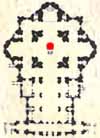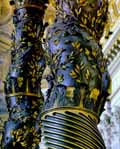| Grottoes
Vatican City Colonnade Saints Floorplan #2 |
| Altars
Monuments The History |
| Related
Items Confessio Pedestals Coat of Arms |
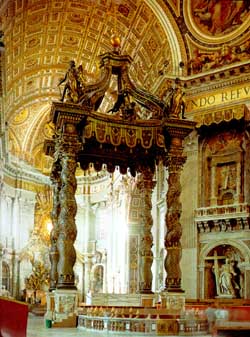
|
The Basilica centers around the Papal Altar where only the Pope celebrates Mass. It was consecrated by Clement VIII, June 5, 1594, on top of several other older altars. Rising above the altar is the baldacchino (95ft. canopy), Bernini's masterpiece and first work in St. Peter's. The ancient tomb of St. Peter lies directly below the altar. An interesting scene of a woman in childbirth appears on the eight coat of arms on the pedestals of the baldacchino.
|
|
Related Articles The
Memorial of the Apostle A
Laborious Delivery
|
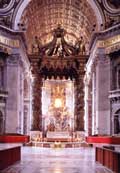 |
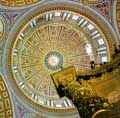 |
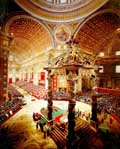 |
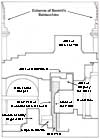 |
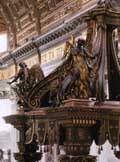 |
|
|
From: 'St. Peter's - Guide to the Basilica and Square'
Next to the Confessio in the center of the basilica stands the high or
papal altar, commonly known as the Altar of the Confessio. It was carved
from a gigantic block of Greek marble which lay in Nerva's Forum, and
was consecrated by Clement VIII on June 26, 1594. It is set on an older
altar erected by Callistus II in 1123, which in turn contains another
even older one.
The altar is surmounted by the splendid, majestic bronze "baldacchino", Bernini's first work in the basilica. He took nine years to make it, from 1624 to 1633, and used 6,200 k. of metal. The monument is typical of the 17th-century style: it stands on four pedestals of marble on which in the papal escutcheons a wonderful sequence showing "motherhood" is carved, liberally scattered with the heraldic bees of the Barberini to whose family Pope Urban VIII belonged. It was he who had commissioned Bernini to make this canopy in 1624. It rests upon four gigantic twisted columns, 20 m. high, adorned with sprigs of olive and bay, among which the graceful figures of cherubs appear, Acanthus leaves entwine the base and the capitals. The spiral fluting of the columns suggests upward movement. Like the portable canopies used in processions to cover the Eucharist, fringes and tassels dangle from the top of the covering. Inside the "ciborium" is a dove, the symbol of the Holy Spirit, in a burst of golden rays. Above the frieze on each capital, four angels, the work of Francois du Duquesnoy, offer garlands, while between them couples of smaller angels support the Pope's emblems: the keys, the tiara, the book and sword. The vertex, where four vast ribs and palm branches converge from the four corners, is crowned by the cross, set on a golden globe.
From:
'St. Peter's Basilica - A Virtual Tour' by Our
Sunday Visitor
Above the Confession, the papal altar rises on seven steps, where only
the Pope can celebrate Mass, facing the people and looking toward the
east as in the old Christian churches. It was installed and consecrated
here in 1594 by Clement VIII using a large block of marble coming from
the Forum of Nerva, including the altar of Callisto II consecrated in
1123.
Baldacchino
A processional type of canopy, supported by poles, in this case consisting
of four metal angels, was placed by Paul V above the altar. But this was
a mediocre and temporary solution and certainly did not match the grandeur
of the Basilica, and especially its location in the real epicenter of
the church.
A deficiency that was immediately recognized by the cultured and ambitious Urban VIII, already from his election in 1623, when he commissioned the favorite Bernini to design a prestigious tabernacle, without any economic restrictions so that the work would be worthy of the site. The artist compensated for such trust in his work by creating a real masterpiece, an emblem of the Baroque style that despite its formal originality and its size (no less than 29 meters tall), is harmoniously inserted into the immensity of the church.
In fact, it compensates for an emptiness that would have been too dominating over the small altar, however without introducing a bulky mass but instead a graceful and streamlined construction. Though imposing, it appears free since it allows the background to be seen quite easily and does not reduce the impression of depth of the Basilica. Instead, it increases the latter making the apse, which can be glimpsed between the columns, seem farther away. Furthermore, despite the inevitable criticism by Milizia, this spectacular work, which in effect is anti-classical in its formal layout, does in fact involve tradition in many aspects.
In fact, Bernini refers to the traditional ciborium of the Middle Ages and the Renaissance, which was still being used during that period. To renew and avoid repeating the usual constructions consisting of a spire or marble dome supported by columns, like a small temple within a temple, he was inspired by the canopy, thus, in the final analysis, replacing a pictorial element with an architectural element. For this purpose he created a cover imitating cloth, producing the feeling of a lightweight structure that is almost mobile and temporary. In a very determinant manner, this involved a solution which was as bold as it was ingenious, to support his "machine" (it is important to recall that Bernini worked with ephemeral constructions that were the fashion in the 17th century, on the occasion of festivities or celebrations), using four streamlined gilded bronze spiral columns, thus avoiding the monotony that four smooth trunks of that extraordinary height would have produced.
He divided it into three levels: the bottom with helical grooves and the two top ones with olive and bay leaf branches, populated by small putti and flying bees, the symbol of the Barberini, inviting the observer to move from one curve to the other of their spiral winding, generating a dynamic and ascending view. Moreover, in this case, Bernini the innovator respected an ancient tradition, because the tabernacle of the Constantinian Basilica had eight spiral marble columns of the same type, which he adopted, restoring them to the loggias of the Relics, in the four pillars of the dome. The columns rest on marble pedestals, decorated by the coat of arms of the Barberini. They terminate with elaborate Corinthian capitals which support a trabeation with shelves, dentils and radiant suns.
The draping canopy rises on this structure, like cloth moved by the wind, surmounted at its apex by a globe with the cross supported by four curving ribs. The corners include four angels bearing floral festoons, executed by Duquesnoy, and on the sides eight festive putti carry the keys and the tiara of St. Peter, as well as the sword and book of St. Paul. The canopy was revealed to the public on St. Peter's day in 1633.
With this work and with the subsequent arrangement of the pillars, Bernini proved that he was really the only one who could audaciously compare with Michelangelo and we believe with great success since he was able to respect the grandeur, even while inserting works that are highly representative of the Baroque period, of which he was undoubtedly an emblematic figure.
This masterpiece led to glory but also criticism, both for the artist and for those who commissioned the work. Firstly because of the enormous costs incurred to obtain the large quantity of bronze that was used. First the ribs of the dome were removed, obtaining 103,229 pounds to which the same amount was added from sources taken from Venice and Leghorn. With other material still required, Urban VIII did not hesitate to remove the bronze of the beams from the Pantheon, and to such an extent that Pasquino made what became a historical statement "quod non fecerunt Barbari fecerunt Barberini" (what the barbarians did not do, the Barberini's did).
The Pantheon, to compensate for the "theft" of its ornaments, which supplied more than the metal needed for the project, was enriched by two bell towers that were immediately shrewdly baptized by the people as "the donkey ears of Bernini." The towers were then demolished in 1883.
As consolation for these pungent statements by the Roman people, Urban VIII earned the glory of such a project and for Bernini a more than generous payment. For the entire project, which required more than 100,000 pounds of bronze and which cost 200,000 scudos, he received 250 monthly payments according to the agreements reached at the beginning of the work, in addition to another donation of 10,000 scudos, plus a canonry for Vincenzo and a patriciate for Domenico his brothers, and the appointment of Luigi to superintendent. Bernini executed numerous small-scale designs, which were gradually reproduced on a larger scale by Borromini.
From:
'THE NEW SAINT PETER'S'
On 1 November 1624, on the anniversary of the consecration of Constantine's
Basilica by Saint Sylvester, the new Basilica was consecrated by Urban
VIII. "It should be noted", we read in the manuscript of Francesco Speroni,
a beneficed cleric of the Basilica, "that the main altar was not consecrated,
having already been consecrated by Clement VIII on 28 June 1594; but it
was raised higher by two steps, ob opus magnificentissimum ibi collocandum".
The opus was the work Bernini was preparing and for which he had made
successive models from 1622 to 1626: namely the famous baldacchino. The
artist took his inspiration from the old one, but raised his to the height
of 64 feet, all in bronze, with spiral columns which repeat the rhythm
of those in the pergolas he had already placed in the tribunes of the
four pilasters. The copper was taken from the ribs of the cupola (which
were recovered with lead), and also, in large measure, from the bronze
lattice of the portico of the Pantheon, as we are told by the commemorative
stone inserted there. This work was officially inaugurated by the Pope
during First Vespers of the feast of Saint Peter in 1633.
From: 'Bernini'
by Rudolf Wittkower © 1997
Baldacchino
Mainly bronze, partly gilt. Principal sculptural parts: four giant bronze
angels above the columns, two pairs of putti with tiara and St Peter's
keys and two pairs with sword and book, emblems of St Paul, between the
scrolls; further small bronze putti on the shafts of the columns, marble
coat of arms on the pedestals; in addition a great mass of minor emblematic
detail in bronze. Whole height 28.5 m. St Peter's, Rome.
The documents for the Baldacchino have been fully published by Pollak, ii, pp. 327-423. Its genesis has been reconstructed by Brauer-Wittkower, pp. 19-22. The work developed slowly to its present form. Bernini was commissioned in 1624, shortly after Urban VIII's election. Payments begin on 12 July of that year. The four bronze columns were unveiled in St Peter's on 29 June 1627. After that date Bernini's attention was focused on the crowning parts and the figures. Inauguration on 29 June 1627, but minor details of the decoration dragged on until 1635. Total expense was over 200,000 scudi, the columns alone costing more than 80,000 scudi. Bernini received 10,000 scudi over the whole period. The immense quantities of bronze were partly looted from the portico of the Pantheon (Pollak, i, p. 175 ff.) and from the ribs of the dome of St Peter's itself.
This was the first work in which Bernini showed his extraordinary gift as an organizer. But he himself was more actively engaged than on similar jobs at a later period. According to a statement of 1627 he had spent three whole years on the manual work of preparing the models and helping to cast the columns. Work, in the beginning, must have been overwhelming. He pressed his family into service; his father, Pietro, seems to have been constantly at his side (Pollak, p. 346) and even helped with the book-keeping. His brother Luigi, was engaged on models and also supervised work. His principal assistants in making the models and preparing them for the founders were Bolgi, Speranza, Finelli, G. A. Fancelli, Niccolo Cordier (probably a namesake of the well-known sculptor who died, according to Baglione, in 1612) and Duquesnoy; the latter had a relatively small share. In 1630 the large models of the angels were ready for casting, but it is impossible to identify the hand of any of the collaborators. Speranza was mainly responsible for the models of the putti with the papal insignia (1633), Bolgi for the touching up of the marble coats of arms of the pedestals (1628) and the older Stefano Maderno for models of small putti for the columns (1624). Finelli's models of SS. Peter and Paul (1628) to be placed in front of the Baldacchino were not cast. It is not clear from the documents (Pollak, p. 368) whether the large figure of Christ which was being planned at a late stage for a position over the Baldacchino, was ever cast. Bernini himself alludes to it in his talks with Chantelou.
